Merits and Limitations of Element Balances as a Forest Planning Tool for Harvest Intensities and Sustainable Nutrient Management—A Case Study from Germany
Abstract
1. Introduction
2. Materials and Methods
2.1. Calculation of Nutrient Balances
2.1.1. Study Sites
2.1.2. Model Formulation
2.1.3. Deposition
2.1.4. Weathering Rates
2.1.5. Leaching of Base Cations
2.1.6. Estimation of Nutrient Export under Different Harvest Intensities
2.2. Regionalization of Nutrient Fluxes and Soil Stocks
2.3. Treatment of Special Sites
2.4. Uncertainty Estimations
3. Results and Discussion
3.1. Nutrient Fluxes of Deposition, Weathering, Leaching and Harvest Removal
3.2. Nutrient Balances for Different Harvest Intensities
3.3. Uncertainties in the Calculated Balances and Methodological Limitations
3.4. Effective Options for Nutrient Management
4. Conclusions
Author Contributions
Funding
Institutional Review Board Statement
Informed Consent Statement
Data Availability Statement
Acknowledgments
Conflicts of Interest
Appendix A
| Scenario | Abbreviation | Description |
|---|---|---|
| Nutrient Saving | MIN | The harvest is limited to saw logs and industrial round wood. The utilization limit varies between top diameters of 12 to 14 cm for softwood and 12 to 17 cm for hardwood species depending on diameter at breast height. Harvest losses remaining on site are assumed to be 10% [33,157]. Brushwood and branch debris are not utilized and remain in the stand interior (not concentrated on the skid trails) through appropriate motorized or mechanized delimbing. In addition, as suggested by Heppelmann et al. [125], debarking of logs takes place inside the stand. This leaves the most nutrient-rich parts (crown material and bark) entirely on site, where they remain available as a source of nutrients. |
| Current harvest intensity | REAL | The main assortments are logs, industrial wood, and fuel wood. All solid volume including bark minus 10% harvest losses is harvested. The utilization limit is set to a top diameter of 7 cm. Harvesting is done by machine and the logging roads are reinforced by half of the arising brushwood volume for soil protection. It is assumed that 80% of the nutrients accumulated in the skid trails with biomass are not available to the system in the medium-term and are thus taken as losses. |
| Highest intensity | MAX | All solid volume is used as log, industrial or fuel wood assuming no technical harvesting losses in the coarse wood fraction. Furthermore, under the same assumptions as in the ‘REAL’ scenario, half of the produced brushwood is placed on the logging roads. In addition, the other half of the crown material, minus harvesting losses of 20% for conifers and 40% for broadleaved trees, is used for energy production or chemical conversion. This scenario thus largely corresponds to a whole-tree harvesting (WTH). |
Appendix B
Estimation of Site Specific Yearly Dry Deposition Factors (DDF)
| Est. | SE | Edf | |
|---|---|---|---|
| Parametric coefficients | |||
| Intercept | 0.23369 *** | 0.02431 | |
| Oak | −0.15948 ** | 0.05046 | |
| Spruce | 0.25400 *** | 0.03381 | |
| Pine | 0.14753 *** | 0.04235 | |
| Approximate significance of smooth terms | |||
| log(BDNa) | 2.608 *** | ||
| WLI | 1.000 ** | ||
| WS | 1.701 *** | ||
| DN | 1.000 *** | ||
| H | 1.000 *** | ||
| R²adj. | 0.648 | n = 928 | |


Appendix C
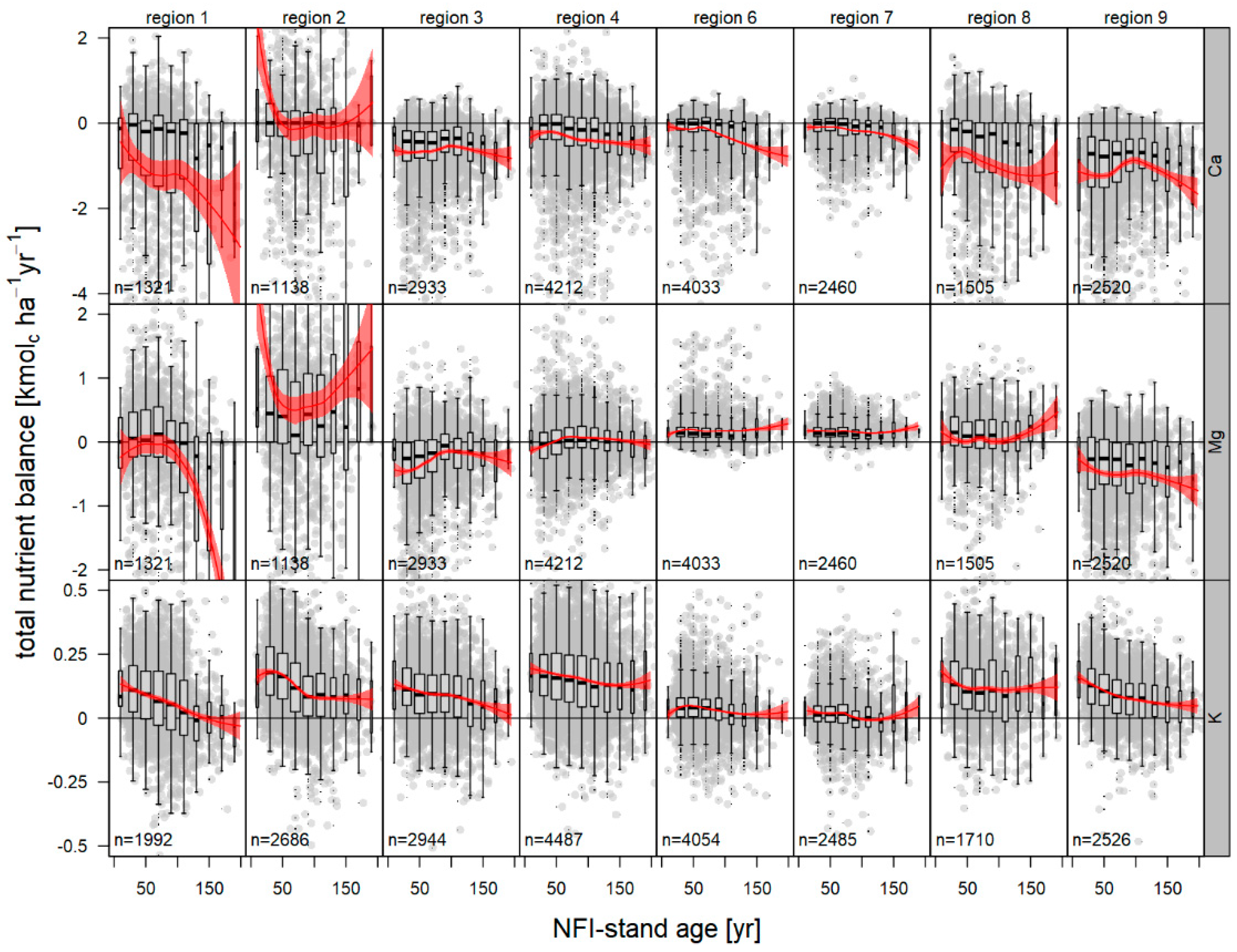
Appendix D
Experimental Design of the Monte Carlo Uncertainty Simulations
| Parameter | Unit | Mean μ | Min | SD[%] | RMSE | R |
|---|---|---|---|---|---|---|
| DEPCa | kg ha−1 yr−1 | modelled results | 0.001 | - | 2.68 | [165] |
| DEPMg | kg ha−1 yr−1 | modelled results | 0.001 | - | 0.43 | [165] |
| DEPK | kg ha−1 yr−1 | modelled results | 0.001 | - | 1.54 | [165] |
| WEACa | kg ha−1 yr−1 | modelled with site specific data | 0.001 | 23.3 | - | [166] |
| WEAMg | kg ha−1 yr−1 | modelled with site specific data | 0.001 | 23.3 | - | [166] |
| WEAK | kg ha−1 yr−1 | modelled with site specific data | 0.001 | 23.3 | - | [166] |
| CSECa | mmolc l−1 | modelled with site specific data | 0.001 | 53.9 | - | [73] |
| CSEMg | mmolc l−1 | modelled with site specific data | 0.001 | 57.5 | - | [73] |
| CSEK | mmolc l−1 | modelled with site specific data | 0.001 | 97.1 | - | [73] |
| SEF | mm | modelled with site specific data | 0.001 | 8.3 | - | [65] |
| STOCa | 0.001 kg ha−1 | measured | 0.001 | 50.0 | - | [167] |
| STOMg | 0.001 kg ha−1 | measured | 0.001 | 50.0 | - | [167] |
| STOK | 0.001 kg ha−1 | measured | 0.001 | 50.0 | - | [167] |
| Model Region | Leaching | Weathering Rate | Soil Stocks | ||||||
|---|---|---|---|---|---|---|---|---|---|
| cf. Figure 2A | Ca | Mg | K | Ca | Mg | K | Ca | Mg | K |
| 1 | 87.9 * | 125.7 * | 80.5 * | 321.8 * | 89.2 * | 55.8 * | 72.7 * | 80.1 * | 51.9 * |
| 2 | 57.3 | 106.9 | 76.8 | 109.8 | 153.8 | 50.8 | 57.7 | 127.3 | 48.6 |
| 3 | 77.5 | 83.3 | 79.1 | 90.7 | 87.2 | 55.8 * | 139.9 | 126.8 | 55.1 |
| 4 | 103.8 | 105.8 | 69.7 | 321.8 * | 132.8 | 54.5 | 110 | 107.1 | 60.2 |
| 6 | 80.8 | 95.8 | 107.6 | 107.5 | 73.4 | 78.6 | 117.9 | 127.6 | 56.6 |
| 7 | 102.9 | 96.8 | 105.1 | 321.8 * | 75.9 | 65 | 71.6 | 103.2 | 51.7 |
| 8 | 80.6 | 76.1 | 81.3 | 47.8 | 47.9 | 51.1 | 89.1 | 86.5 | 50.1 |
| 9 | 119.2 | 125.7 * | 95 | 321.8 * | 261 | 65 | 112.2 | 65 | 136.8 |
| X | 87.9 | 125.7 | 80.5 | 321.8 | 89.2 | 55.8 | 72.7 | 80.1 | 51.9 |
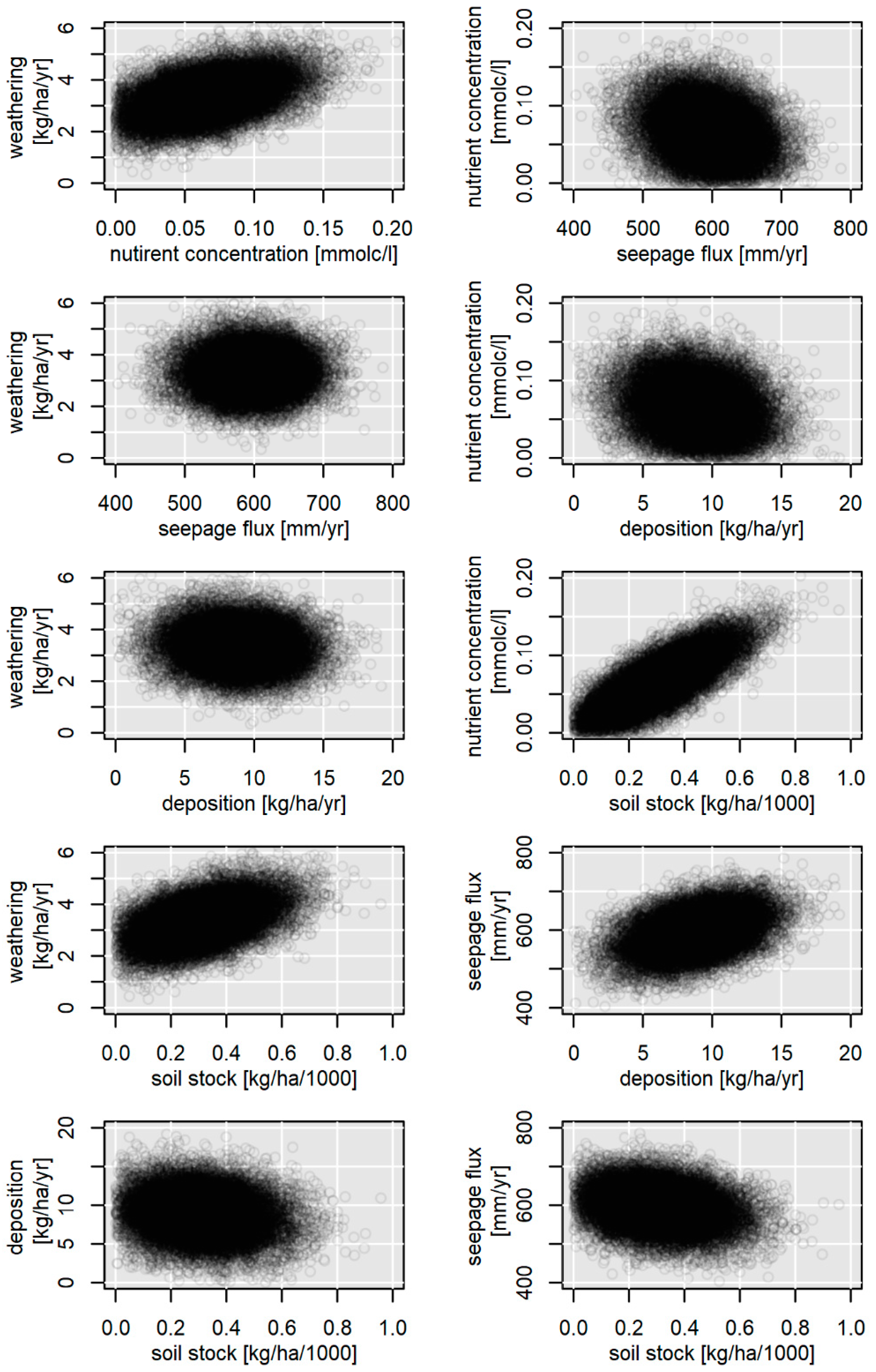
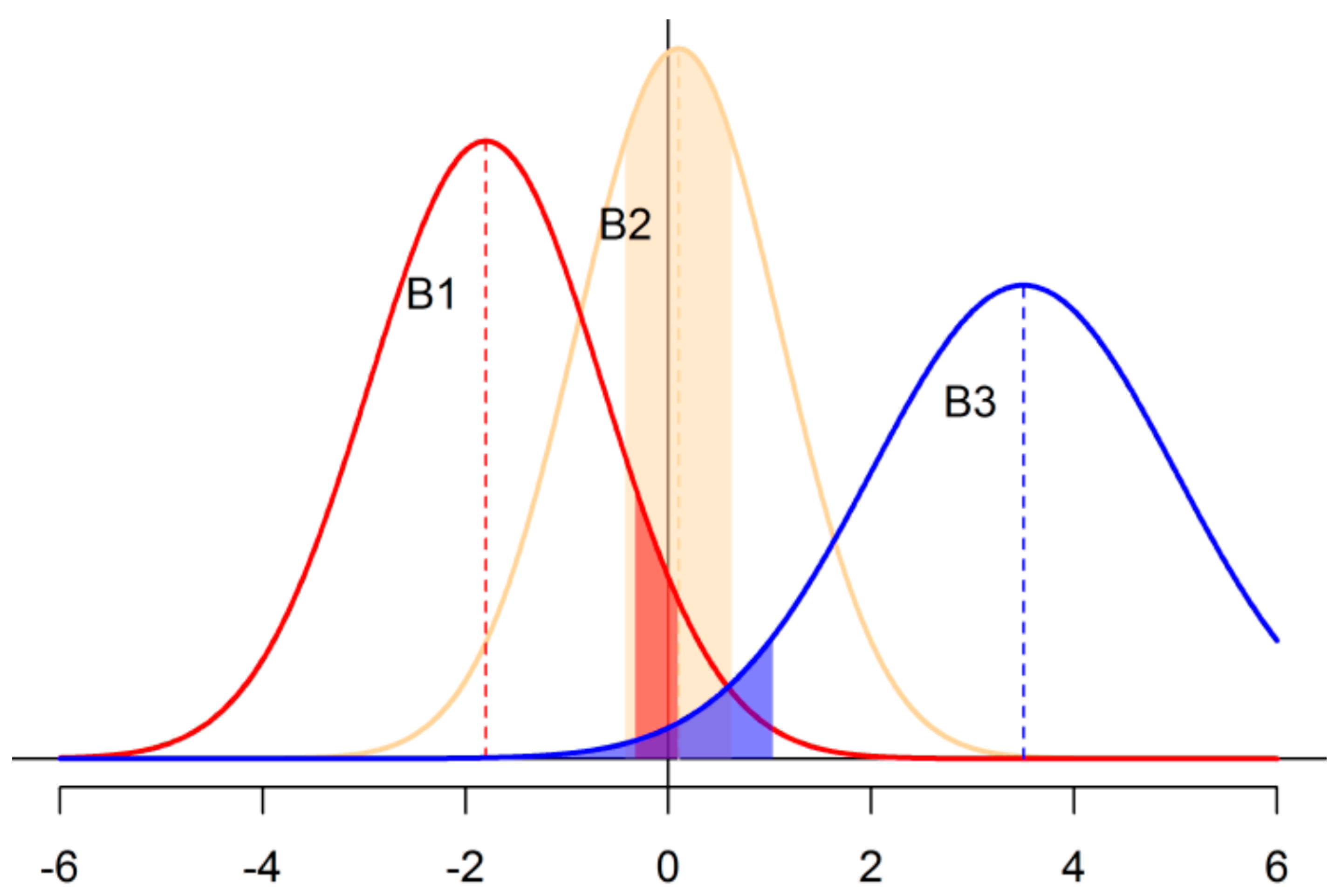
Appendix E
Validation of the Regionalized Nutrient Balances


References
- Lindberg, S.E.; Lovett, G.M.; Richter, D.D.; Johnson, D.W. Atmospheric deposition and canopy interactions of major ions in a forest. Science 1986, 231, 141–145. [Google Scholar] [CrossRef]
- Hedin, L.O.; Granat, L.; Likens, G.E.; Buishand, T.A.; Galloway, J.N.; Butler, T.J.; Rodhe, H. Steep declines in atmospheric base cations in regions of Europe and North America. Nature 1994, 367, 351–354. [Google Scholar] [CrossRef]
- Meesenburg, H.; Meiwes, K.-J.; Rademacher, P. Long term trends in atmospheric deposition and seepage output in northwest german forest ecosystems. Water Air Soil Pollut. 1995, 85, 611–616. [Google Scholar] [CrossRef]
- Engardt, M.; Simpson, D.; Schwikowski, M.; Granat, L. Deposition of sulphur and nitrogen in Europe 1900–2050. Model calculations and comparison to historical observations. Tellus Ser. B 2017, 69, 1328945. [Google Scholar] [CrossRef]
- Meesenburg, H.; Ahrends, B.; Fleck, S.; Wagner, M.; Fortmann, H.; Scheler, B.; Klinck, U.; Dammann, I.; Eichhorn, J.; Mindrup, M.; et al. Long-term changes of ecosystem services at Solling, Germany: Recovery from acidification, but increasing nitrogen saturation? Ecol. Indic. 2016, 65, 103–112. [Google Scholar] [CrossRef]
- Vestreng, V.; Myhre, G.; Fagerli, H.; Reis, S.; Tarrasón, L. Twenty-five years of continuous sulphur dioxide emission reduction in Europe. Atmos. Chem. Phys. 2007, 7, 3663–3681. [Google Scholar] [CrossRef]
- de Vries, W.; de Jong, A.; Kros, J.; Spijker, J. The use of soil nutrient balances in deriving forest biomass harvesting guidelines specific to region, tree species and soil type in the Netherlands. For. Ecol. Manag. 2021, 479, 118591. [Google Scholar] [CrossRef]
- Rytter, L.; Ingerslev, M.; Kilpeläinen, A.; Torssonen, P.; Lazdina, D.; Löf, M.; Madsen, P.; Muiste, P.; Stener, L.-G. Increased forest biomass production in the Nordic and Baltic countries—A review on current and future opportunities. Silva Fenn. 2016, 50, 5. [Google Scholar] [CrossRef]
- Busch, R.; Hirth, T.; Liese, A.; Nordhoff, S.; Puls, J.; Pulz, O.; Sell, D.; Syldatk, C.; Ulber, R. Nutzung nachwachsender Rohstoffe in der industriellen Stoffproduktion. Chem. Ing. Tech. 2006, 78, 219–228. [Google Scholar] [CrossRef]
- Flückiger, W.; Braun, S. Nährstoffe im Wald lassen-oder recyclieren! Wald. Und Holz 2009, 9, 30–33. [Google Scholar]
- Jacobsen, C.; Rademacher, P.; Meesenburg, H.; Meiwes, K.J. Gehalte chemischer Elemente in Baumkompartimenten—Literaturstudie und Datensammlung. In Berichte des Forschungszentrums Waldökosysteme; Reihe B 69; Selbstverlag des Forschungszentrums Waldökosysteme der Universität Göttingen: Göttingen, Germany, 2003; 81p. [Google Scholar]
- Rumpf, S.; Schönfelder, E.; Ahrends, B. Biometrische Schätzmodelle für Nährelementgehalte in Baumkompartimenten. Freibg. Forstl. Forsch. 2018, 101, 33–73. [Google Scholar]
- Aherne, J.; Posch, M.; Forsius, M.; Lehtonen, A.; Härkönen, K. Impacts of forest biomass removal on soil nutrient status under climate change: A catchment-based modelling study for Finland. Biogeochemistry 2012, 107, 471–488. [Google Scholar] [CrossRef]
- Vanguelova, E.; Pitman, R.; Luiro, J.; Helmisaari, H.-S. Long term effects of whole tree harvesting on soil carbon and nutrient sustainability in the UK. Biogeochemistry 2010, 101, 43–59. [Google Scholar] [CrossRef]
- Marčeta, D.; Petković, V.; Ljubojević, D.; Potočnik, I. Harvesting System Suitability as Decision Support in Selection Cutting Forest Management in Northwest Bosnia and Herzegovina. Croat. J. For. Eng. 2020, 41, 251–265. [Google Scholar] [CrossRef]
- Block, J.; Meiwes, K.J. Erhaltung der Produktivität der Waldböden bei der Holz- und Biomassenutzung. In Bodenschutz—Ergänzbares Handbuch der Maßnahmen und Empfehlungen für Schutz, Pflege und Sanierung von Böden, Landschaft und Grundwasser; Bachmann, G., König, W., Utermann, J., Eds.; Erich Schmidt Verlag GmbH & Co. KG: Berlin, Germany, 2013; Volume 4200, pp. 1–50. [Google Scholar]
- Titus, B.D.; Brown, K.; Helmisaari, H.-S.; Vanguelova, E.; Stupak, I.; Evans, A.; Clarke, N.; Guidi, C.; Bruckman, V.J.; Varnagiryte-Kabasinskiene, I.; et al. Sustainable forest biomass: A review of current residue harvesting guidelines. Energy Sustain. Soc. 2021, 11, 10. [Google Scholar] [CrossRef]
- Stupak, I.; Raulund-Rasmussen, K. Historical, ecological, and governance aspects of intensive forest biomass harvesting in Denmark. WIREs Energy Environ. 2016, 5, 588–610. [Google Scholar] [CrossRef]
- Fleck, S.; Eickenscheidt, N.; Ahrends, B.; Evers, J.; Grüneberg, E.; Ziche, D.; Höhle, J.; Schmitz, A.; Weis, W.; Schmidt-Walter, P.; et al. Nitrogen Status and Dynamics in German Forest Soils. In Ecological Studies (Analysis and Synthesis); Wellbrock, N., Bolte, A., Eds.; Springer International Publishing: Cham, Switzerland, 2019; Volume 237, pp. 123–166. [Google Scholar]
- Akselsson, C.; Westling, O.; Sverdrup, H.; Holmqvist, J.; Thelin, G.; Uggla, E.; Malm, E. Impact of Harvest Intensity on Long-Term Base Cation Budgets in Swedish Forest Soils. Water Air Soil Pollut. Focus 2007, 7, 201–210. [Google Scholar] [CrossRef]
- Olsson, B.A.; Bengtsson, J.; Lundkvist, H. Effects of different forest harvest intensities on the pools of exchangeable cations in coniferous forest soils. For. Ecol. Manag. 1996, 84, 135–147. [Google Scholar] [CrossRef]
- Joki-Heiskala, P.; Johansson, M.; Holmberg, M.; Mattsson, T.; Forsius, M.; Kortelainen, P.; Hallin, L. Long-term base cation balances of forest mineral soils in Finland. Water Air Soil Pollut. 2003, 150, 255–273. [Google Scholar] [CrossRef]
- Forsius, M.; Akujärvi, A.; Mattsson, T.; Holmberg, M.; Punttila, P.; Posch, M.; Liski, J.; Repo, A.; Virkkala, R.; Vihervaara, P. Modelling impacts of forest bioenergy use on ecosystem sustainability: Lammi LTER region, southern Finland. Ecol. Indic. 2016, 65, 66–75. [Google Scholar] [CrossRef]
- Likens, G.E.; Bormann, F.M.; Pierce, R.S.; Eaton, J.S.; Johnson, N.M. Biochemistry of a Forested Ecosystem; Springer: New York, NY, USA, 1977; p. 146. [Google Scholar]
- Levers, C.; Verkerk, P.J.; Müller, D.; Verburg, P.H.; Butsic, V.; Leitão, P.J.; Lindner, M.; Kuemmerle, T. Drivers of forest harvesting intensity patterns in Europe. For. Ecol. Manag. 2014, 315, 160–172. [Google Scholar] [CrossRef]
- Achat, D.L.; Deleuze, C.; Landmann, G.; Pousse, N.; Ranger, J.; Augusto, L. Quantifying consequences of removing harvesting residues on forest soils and tree growth—A meta-analysis. For. Ecol. Manag. 2015, 348, 124–141. [Google Scholar] [CrossRef]
- Thiffault, E.; Hannam, K.D.; Pare, D.; Titus, B.D.; Hazlett, P.W.; Maynard, D.G.; Brais, S. Effects of forest biomass harvesting on soil productivity in boreal and temperate forests—A review. Environ. Rev. 2011, 19, 278–309. [Google Scholar] [CrossRef]
- Zetterberg, T.; Köhler, S.J.; Löfgren, S. Sensitivity analyses of MAGIC modelled predictions of future impacts of whole-tree harvest on soil calcium supply and stream acid neutralizing capacity. Sci. Total Environ. 2014, 494–495, 187–201. [Google Scholar] [CrossRef] [PubMed]
- Egnell, G.; Valinger, E. Survival, growth, and growth allocation of planted Scots pine trees after different levels of biomass removal in clear felling. For. Ecol. Manag. 2003, 177, 65–74. [Google Scholar] [CrossRef]
- Evans, A.M.; Finkral, A.J. From renewable energy to fire risk reduction: A synthesis of biomass harvesting and utilization case studies in US forests. GCB Bioenergy 2009, 1, 211–219. [Google Scholar] [CrossRef]
- Mason, W.L.; Mckay, H.M.; Weatherall, A.; Connolly, T.; Harrison, A.J. The effects of whole-tree harvesting on three sites in upland Britain on the growth of Sitka spruce over ten years. For. Int. J. For. Res. 2011, 85, 111–123. [Google Scholar] [CrossRef]
- Kreutzweiser, D.P.K.P.; Hazlett, P.W.H.W.; Gunn, J.M.G.M. Logging impacts on the biogeochemistry of boreal forest soils and nutrient export to aquatic systems: A review. Environ. Rev. 2008, 16, 157–179. [Google Scholar] [CrossRef]
- Wilpert, V.K.; Bösch, B.; Bastian, P.; Zirlewagen, D.; Hepperle, F.; Holzmann, S.; Puhlmann, H.; Schäffer, J.; Kändler, G.; Sauter, U.H. Biomasse-Aufkommensprognose und Kreislaufkonzepte für den Einsatz von Holzaschen in der Bodenschutzkalkung in Oberschwaben. Ber. Freibg. Forstl. Forsch. 2011, 87, 155. [Google Scholar]
- Riek, W.; Russ, A.; Kühn, D. Waldbodenbericht Brandenburg. Zustand und Entwicklung der brandenburgischen Waldböden. Ergebnisse der landesweiten Bodenzustandserhebungen BZE-2 und BZE-2a. Eberswalder Forstl. Schr. 2015, 60, 172. [Google Scholar]
- Ahrends, B.; Scheler, B.; Wagner, M.; Fleck, S.; Fortmann, H.; Meesenburg, H. Trends der Nährstoffbilanzen forstlich genutzter Intensiv-BDF in Niedersachsen. Geoberichte 2021, 39, 40–54. [Google Scholar] [CrossRef]
- Knust, C.; Schua, K.; Feger, K.-H. Estimation of Nutrient Exports Resulting from Thinning and Intensive Biomass Extraction in Medium-Aged Spruce and Pine Stands in Saxony, Northeast Germany. Forests 2016, 7, 302. [Google Scholar] [CrossRef]
- Borken, W.; Matzner, E. Nitrate leaching in forest soils: An analysis of long-term monitoring sites in Germany. J. Plant Nutr. Soil Sci. 2004, 167, 277–283. [Google Scholar] [CrossRef]
- Brumme, R.; Ahrends, B.; Block, J.; Schulz, C.; Meesenburg, H.; Klinck, U.; Wagner, M.; Khanna, P. Cycling and retention of nitrogen in European beech (Fagus sylvatica L.) ecosystems under elevated fructification frequency. Biogeosciences 2021, 18, 3763–3779. [Google Scholar] [CrossRef]
- Paré, D.; Thiffault, E. Nutrient Budgets in Forests Under Increased Biomass Harvesting Scenarios. Curr. For. Rep. 2016, 2, 81–91. [Google Scholar] [CrossRef]
- Sutton, M.A.; Oenema, O.; Erisman, J.W.; Leip, A.; van Grinsven, H.; Winiwarter, W. Too much of a good thing. Nature 2011, 472, 159–161. [Google Scholar] [CrossRef]
- Bol, R.; Julich, D.; Brödlin, D.; Siemens, J.; Kaiser, K.; Dippold, M.A.; Spielvogel, S.; Zilla, T.; Mewes, D.; von Blanckenburg, F.; et al. Dissolved and colloidal phosphorus fluxes in forest ecosystems—An almost blind spot in ecosystem research. J. Plant Nutr. Soil Sci. 2016, 179, 425–438. [Google Scholar] [CrossRef]
- Missong, A.; Holzmann, S.; Bol, R.; Nischwitz, V.; Puhlmann, H.; Kaiser, K.; Siemens, J.; Klumpp, E. Leaching of natural colloids from forest topsoils and their relevance for phosphorus mobility. Sci. Total Environ. 2018, 634, 305–315. [Google Scholar] [CrossRef]
- Ulrich, B. Natural and anthropogenic components of soil acidification. J. Plant Nutr. Soil Sci. 1986, 149, 702–717. [Google Scholar] [CrossRef]
- Sverdrup, H.; Thelin, G.; Robles, M.; Stjernquist, I.; Sörensen, J. Assesing nutrient sustainability of forest production for different tree species considering Ca, Mg, K, N and P at Björnstorp Estate, Sweden. Biogeochemistry 2006, 81, 219–238. [Google Scholar] [CrossRef]
- Builtjes, P.; Hendriks, E.; Koenen, M.; Schaap, M.; Banzhaf, S.; Kerschbaumer, A.; Gauger, T.; Nagel, H.-D.; Scheuschner, T.; Schlutow, A. Erfassung, Prognose und Bewertung von Stoffeinträgen und ihren Wirkungen in Deutschland (Modelling of Air Pollutants and Ecosystem Impact—MAPESI); Federal Environmental Agency: Dessau-Rosslau, Germany, 2011; p. 97.
- Schaap, M.; Wichink Kruit, R.J.; Hendriks, C.; Kranenburg, R.; Segers, A.; Builtjes, P.; Banzhaf, S.; Scheuschner, T. Atmospheric Deposition to German Natural and Semi-Natural Ecosystems during 2009; Umweltbundesamt: Dessau-Roßlau, Germany, 2015; p. 82.
- Ulrich, B. Nutrient and Acid-Base Budget of Central European Forest Ecosystems. In Effects of Acid Rain on Forest Processes; Godbold, D., Hüttermann, A., Eds.; Wiley-Liss: New York, NY, USA, 1994; pp. 1–50. [Google Scholar]
- Devlaeminck, R.; Schrijver, D.A.; Hermy, M. Variation in throughfall deposition across a deciduous beech (Fagus sylvatica L.) forest edge in Flanders. Sci. Total Environ. 2005, 337, 241–252. [Google Scholar] [CrossRef] [PubMed]
- Staelens, J.; Houle, D.; De Schrijver, A.; Neirynck, J.; Verheyen, K. Calculating dry deposition and canopy exchange with the canopy budget model: Review of assumptions and application to two deciduous forests. Water Air Soil Pollut. 2008, 191, 149–169. [Google Scholar] [CrossRef]
- Zuur, A.F.; Ieno, E.N.; Walker, N.J.; Saveliev, A.A.; Smith, G.M. Mixed Effects Models and Extensions in Ecology with R; Springer: New York, NY, USA, 2009; p. 574. [Google Scholar] [CrossRef]
- Clarke, N.; Zlindra, D.; Ulrich, E.; Mosello, R.; Derome, J.; Derome, K.; König, N.; Lövblad, G.; Draaijers, G.; Hansen, K.; et al. Part XIV: Sampling and Analysis of Deposition. Available online: https://storage.ning.com/topology/rest/1.0/file/get/9995560266?profile=original (accessed on 17 February 2022).
- Gauger, T.; Anshelm, F.; Schuster, H.; Draaijers, G.P.J.; Bleeker, A.; Erisman, J.W.; Vermeulen, A.T.; Nagel, H.-D. Kartierung Ökosystembezogener Langzeittrends Atmosphärischer Stoffeinträge und Luftschadstoffkonzentrationen in Deutschland und deren Vergleich mit Critical Loads und Critical Levels; Institut für Navigation, Universität: Stuttgart, Germany, 2002; p. 207. [Google Scholar]
- RDevelopmentCoreTeam. R: A Language and Environment for Statistical Computing; R Foundation for Statistical Computing: Vienna, Austria, 2013; ISBN 3-900051-07-0. Available online: http://www.R-project.org (accessed on 7 June 2015).
- Conrad, O.; Bechtel, B.; Bock, M.; Dietrich, H.; Fichter, E.; Gerlitz, L.; Wehberg, J.; Wichmann, V.; Böhner, J. System for Automated Geoscientific Analyses (SAGA) v. 2.1.4. Geosci. Model Dev. 2015, 8, 1991–2007. [Google Scholar] [CrossRef]
- Sverdrup, H.; Warfvinge, P. Calculating field weathering rates using a mechanistic geochemical model PROFILE. Appl. Geochem. 1993, 8, 273–283. [Google Scholar] [CrossRef]
- Stendahl, J.; Akselsson, C.; Melkerud, P.-A.; Belyazid, S. Pedon-scale silicate weathering: Comparison of the PROFILE model and the depletion method at 16 forest sites in Sweden. Geoderma 2013, 211–212, 65–74. [Google Scholar] [CrossRef]
- Akselsson, C.; Belyazid, S.; Stendahl, J.; Finlay, R.; Olsson, B.A.; Erlandsson Lampa, M.; Wallander, H.; Gustafsson, J.P.; Bishop, K. Weathering rates in Swedish forest soils. Biogeosciences 2019, 16, 4429–4450. [Google Scholar] [CrossRef]
- Akselsson, C.; Kronnäs, V.; Stadlinger, N.; Zanchi, G.; Belyazid, S.; Karlsson, P.E.; Hellsten, S.; Karlsson, G.P. A Combined Measurement and Modelling Approach to Assess the Sustainability of Whole-Tree Harvesting—A Swedish Case Study. Sustainability 2021, 13, 2395. [Google Scholar] [CrossRef]
- Koseva, I.S.; Watmough, S.A.; Aherne, J. Estimating base cation weathering rates in Canadian forest soils using a simple texture-based model. Biogeochemistry 2010, 2010, 183–196. [Google Scholar] [CrossRef]
- Phelan, J.; Belyazid, S.; Kurz, D.; Guthrie, S.; Cajka, J.; Sverdrup, H.; Waite, R. Estimation of Soil Base Cation Weathering Rates with the PROFILE Model to Determine Critical Loads of Acidity for Forested Ecosystems in Pennsylvania, USA: Pilot Application of a Potential National Methodology. Water Air Soil Pollut. 2014, 225, 2109. [Google Scholar] [CrossRef]
- Whitfield, C.J.; Watmough, S.A.; Aherne, J.; Dillon, P.J. A comparison of weathering rates for acid-sensitive catchments in Nova Scotia, Canada and their impact on critical load calculations. Geoderma 2006, 136, 899–911. [Google Scholar] [CrossRef]
- Hodson, M.E.; Langan, S.J.; Wilson, M.J. A sensitivity analysis of the Profile model in relation to the calculation of soil weathering rates. Appl. Geochem. 1996, 11, 835–844. [Google Scholar] [CrossRef]
- Jönsson, C.; Warfvinge, P.; Sverdrup, H. Uncertainty in predicting weathering rate and environmental stress factors with the PROFILE model. Water Air Soil Pollut. 1995, 81, 1–23. [Google Scholar] [CrossRef]
- Hammel, K.; Kennel, M. Charakterisierung und Analyse der Wasserverfügbarkeit und des Wasserhaushalts von Waldstandorten in Bayern mit dem Simulationsmodell BROOK90; Heinrich Frank: München, Germany, 2001; Volume 185, p. 148. [Google Scholar]
- Ahrends, B.; Schmidt-Walter, P.; Fleck, S.; Köhler, M.; Weis, W. Wasserhaushaltssimulationen und Klimadaten. Freibg. Forstl. Forsch. 2018, 101, 74–94. [Google Scholar]
- Schmidt-Walter, P.; Ahrends, B.; Mette, T.; Puhlmann, H.; Meesenburg, H. NFIWADS: The water budget, soil moisture, and drought stress indicators database for German National Forest Inventory (NFI). Ann. Forest Sci. 2019, 76, 39. [Google Scholar] [CrossRef]
- Puhlmann, H.; Schmidt-Walter, P.; Hartmann, P.; Meesenburg, H.; von Wilpert, K. Soil Water Budget and Drought Stress. In Status and Dynamics of Forests in Germany: Results of the National Forest Monitoring; Wellbrock, N., Bolte, A., Eds.; Springer International Publishing: Cham, Switzerland, 2019; pp. 55–91. [Google Scholar]
- Posch, M.; Kurz, D. A2M—A program to compute all possible mineral modes from geochemical analyses. Comput. Geosci. 2007, 33, 563–572. [Google Scholar] [CrossRef]
- GAFA. Handbuch Forstliche Analytik (HFA). Grundwerk des Gutachterausschuss Forstliche Analytik (GAFA); Federal Ministry of Food, Agriculture and Consumer Protection, Northwest German Forest Research Institute: Bonn, Germany, 2005. [Google Scholar]
- GAFA. Handbuch Forstliche Analytik (HFA). Grundwerk und 1.—4. Ergänzung des Gutachterausschuss Forstliche Analytik (GAFA); Federal Ministry of Food, Agriculture and Consumer Protection, Northwest German Forest Research Institute: Bonn, Germany, 2009. [Google Scholar]
- GAFA. Handbuch Forstliche Analytik (HFA). Grundwerk und 1.—5. Ergänzung des Gutachterausschuss Forstliche Analytik (GAFA); Federal Ministry of Food, Agriculture and Consumer Protection, Northwest German Forest Research Institute: Bonn, Germany, 2014. [Google Scholar]
- Wellbrock, N.; Ahrends, B.; Bögelein, R.; Bolte, A.; Eickenscheidt, N.; Grüneberg, E.; König, N.; Schmitz, A.; Fleck, S.; Ziche, D. Concept and Methodology of the National Forest Soil Inventory. In Status and Dynamics of Forests in Germany; Wellbrock, N., Bolte, A., Eds.; Ecological Studies; Springer Nature Schwitzerland AG: Cham, Switzerland, 2019; Volume 237. [Google Scholar]
- Weis, W.; Schäff, T.; Köhler, D.; Kölling, C. Stoffausträge mit dem Sickerwasser für die BZE II. Freibg. Forstl. Forsch. 2018, 101, 181–205. [Google Scholar]
- Bösch, B.; Kändler, G. WEHAM II—Modelle und Algorithmen. Available online: https://www.bundeswaldinventur.de/fileadmin/SITE_MASTER/content/Downloads/Modelle_und_Algorithmen.pdf (accessed on 11 February 2022).
- Rock, J.; Bösch, B.; Kändler, G. WEHAM 2012—Waldentwicklungs- und Holzaufkommensmodellierung für die dritte Bundeswaldinventur. Deutscher Verband Forstlicher Versuchsanstalten (DVFFA). In Sektion Ertragskunde: Berichte zur Jahrestagung 2013; Kohnle, U., Klädtke, J., Eds.; Forstliche Versuchsanstalt Baden-Württemberg: Freiburg, Germany, 2013; pp. 127–133. [Google Scholar]
- Vonderach, C.; Kändler, G.; Dormann, C.F. Consistent set of additive biomass functions for eight tree species in Germany fit by nonlinear seemingly unrelated regression. Ann. For. Sci. 2018, 75, 49. [Google Scholar] [CrossRef]
- Kublin, E. Einheitliche Beschreibung der Schaftform—Methoden und Programme—BDATPro. Forstwiss. Cent. Ver. Mit Tharandter Forstl. Jahrb. 2003, 122, 183–200. [Google Scholar] [CrossRef]
- Block, J.; Schuck, J. Nährstoffentzüge durch die Holzernte und ihr Einfluss auf den Nährstoffhaushalt armer Standorte in Rheinland-Pfalz. Forstl. Forsch. München 2002, 186, 150–151. [Google Scholar]
- NW-FVA. Weichlaubholz—Ungenutztes Rohstoffpotenzial!? Abschlussbericht des Projekts "WEIPOL" im Rahmen des Förderungsprogramms “Nachwachsende Rohstoffe" des BMELV; Technische Informationsbibliothek u. Universitätsbibliothek: Göttingen, Germany, 2013; p. 220. [Google Scholar]
- Göttlein, A.; Dieler, D.; Baumgarten, M. Tree-internal Nutrient Distribution of Beech and Spruce at the Kranzberger Forst—Implications for Efficiency of Wood Production and for Nutrient Export with Different Harvest Intensities. Nova Acta Leopold. NF 2013, 114, 255–265. [Google Scholar]
- Huber, C.; Borchert, H.; Kremer, J.; Weis, W.; Metthies, D.; Göttlein, A. Biomasse-und Nährelementverschiebungen bzw.-verluste bei Harvesterdurchforstungen und deren Auswirkungen auf Bodeneigenschaften und Stoffhaushalt von Waldökosystemen. Abschlussbericht zum Projekt B65 des Kuratoriums für forstliche Forschung in Bayern; LWF: Freising, Germany, 2011; p. 95. [Google Scholar]
- Pretzsch, H.; Block, J.; Dieler, J.; Gauer, J.; Göttlein, A.; Moshammer, R.; Schuck, J.; Weis, W.; Wunn, U. Nährstoffentzüge durch die Holz- und Biomassenutzung in Wäldern. Teil 1: Schätzfunktionen für Biomasse und Nährelemente und ihre Anwendung in Szenariorechnungen. Allg. Forst- Und Jagdztg. 2014, 185, 261–285. [Google Scholar]
- Rademacher, P.; Schönfelder, E.; Meiwes, K.J. Elementgehalte in Baumkompartimenten von Fichte (Picea abies [L.] Karst), Kiefer (Pinus sylvestris [L.] Karst), Buche (Fagus sylvatica [L.] Karst), (Eiche Quercus robur und petraea [L.] Karst) und Douglasie (Pseudotsuga menziesii [L.] Karst). Forsch.: Möglichkeiten Und Grenzen Der Vollbaumnutzung (FKZ: 22015407) 2012, 125–154. Available online: https://www.fnr-server.de/ftp/pdf/berichte/22015407.pdf (accessed on 14 April 2022).
- Rumpf, S.; Husmann, K.; Döbbeler, H.; Spellmann, H.; Nagel, J.; Meiwes, K.J. Ergebnisbericht. Verbundvorhaben: Bioenergie-Regionen Stärken (BEST)-Neue Systemlösungen im Spannungsfeld Ökologischer, Ökonomischer und Sozialer Anforderungen-Teilprojekt: Schwachholzpotenzial Wald (IO-H 4)-Entscheidungswerkzeuge zur Sicherung Einer Nachhaltigen Rohstoffversorgung für die Stoffliche und Energetische Verwertung; BMBF (FKZ: 003L033F). 2014. Available online: https://www.fisaonline.de/projekte-finden/details/?tx_fisaresearch_projects%5Bp_id%5D=5961&tx_fisaresearch_projects%5Baction%5D=projectDetails&tx_fisaresearch_projects%5Bcontroller%5D=Projects&cHash=c53771cb89d9664b6f6634165a180a60 (accessed on 20 February 2022).
- Weis, W.; Gruber, A.; Huber, C.; Göttlein, A. Element concentrations and storage in the aboveground biomass of limed and unlimed Norway spruce trees at Höglwald. Eur. J. For. Res. 2009, 128, 437–445. [Google Scholar] [CrossRef]
- Weis, W.; Göttlein, A. Appendix. In Stoffliche Nachhaltigkeitskriterien für die Bayerische Forstwirtschaft. Abschlussbericht zum Projekt B67 des Kuratoriums für Forstliche Forschung in Bayern; TUM: München, Germany, 2012; p. 140. [Google Scholar]
- Weis, W.; Blumenthal, B.; Göttlein, A. Baumartenvergleich in intakten Altbeständen. Forstl. Forsch. Ber. Münch. 2014, 212, 13–38. [Google Scholar]
- Weis, W.; Göttlein, A. Bewirtschaftungsmöglichkeiten zur Sicherung einer nachhaltigen Waldwirtschaft vor dem Hintergrund der Nährstoffversorgung kalkalpiner Standorte. Forstl. Schr. Univ. Für Bodenkult. Wien 2016, 21, 97–127. [Google Scholar]
- Miller, D.M. Reducing Transformation Bias in Curve Fitting. Am. Stat. 1984, 38, 124–126. [Google Scholar] [CrossRef]
- Forests, ICP. Manual on Methods and Criteria for Harmonized Sampling, Assessment, Monitoring and Analysis of the Effects of Air Pollution on Forests. Available online: http://icp-forests.net/page/icp-forests-manual (accessed on 12 February 2021).
- Greve, M. Langfristige Auswirkungen der Waldkalkung auf den Stoffhaushalt. Mitt. Aus Der Forsch. Für Wald. Und Forstwirtsch. Rheinl.-Pfalz. 2015, 73, 333. [Google Scholar]
- Huber, C.; Baier, R.; Göttlein, A.; Weis, W. Changes in soil, seepage water and needle chemistry between 1984 and 2004 after liming an N-saturated Norway sprcue stand at the Höglwald, Germany. For. Ecol. Manage. 2006, 233, 11–20. [Google Scholar] [CrossRef]
- Zirlewagen, D. Regionalisierung der Bodenbilanz an BWI-Punkten. Freibg. Forstl. Forsch. 2018, 101, 227–241. [Google Scholar]
- Kolka, R.K.; Grigal, D.F.; Nater, E.A. Forest soil mineral weathering rates: Use of multiple approaches. Geoderma 1996, 73, 1–21. [Google Scholar] [CrossRef]
- Oenema, O.; Kros, H.; de Vries, W. Approaches and uncertainties in nutrient budgets: Implications for nutrient management and environmental policies. Eur. J. Agron. 2003, 20, 3–16. [Google Scholar] [CrossRef]
- Cartwright, S.J.; Bowgen, K.M.; Collop, C.; Hyder, K.; Nabe-Nielsen, J.; Stafford, R.; Stillman, R.A.; Thorpe, R.B.; Sibly, R.M. Communicating complex ecological models to non-scientist end users. Ecol. Model. 2016, 338, 51–59. [Google Scholar] [CrossRef]
- Arrouays, D.; McBratney, A.; Bouma, J.; Libohova, Z.; Richer-de-Forges, A.C.; Morgan, C.L.S.; Roudier, P.; Poggio, L.; Mulder, V.L. Impressions of digital soil maps: The good, the not so good, and making them ever better. Geoderma Reg. 2020, 20, e00255. [Google Scholar] [CrossRef]
- Yanai, R.D.; Battles, J.J.; Richardson, A.D.; Blodgett, C.A.; Wood, D.M.; Rastetter, E.B. Estimating Uncertainty in Ecosystem Budget Calculations. Ecosystems 2010, 13, 239–248. [Google Scholar] [CrossRef]
- Li, H.; Wu, J. Uncertainty analysis in ecological studies. In Scaling and Uncertrainty Analysis in Ecology: Methods and Applications; Wu, J., Jones, K.B., Li, H., Loucks, O.L., Eds.; Springer: Cham, Switzerland, 2006; pp. 45–66. [Google Scholar]
- Constantine, W.; Hesterberg, T.; Wittkowski, K.; Song, T.; Kaluzny, S. splus2R: Supplemental S-PLUS Functionality in R. R Package Version 1.2-0. 2013. Available online: http://CRAN.R-project.org/package=splus2R (accessed on 14 April 2022).
- Posch, M.; Vries de, W.; Sverdrup, H. Mass Balance models to derive critical loads of nitrogen and acidity for terrestrial and aquatic ecosystems. In Critical Loads and Dynamic Risk Assessments; de Vries, W., Hettelingh, J.-P., Posch, M., Eds.; Environmental Pollution; Springer: Dordrecht, The Netherlands, 2015; Volume 25, pp. 171–205. [Google Scholar]
- de Vries, W.; Breeuwsma, A. Relative importance of natural and anthropogenic proton sources in soils in the netherlands. Water Air Soil Pollut. 1986, 28, 173–184. [Google Scholar] [CrossRef]
- Breemen, N.V.; Visser, P.H.B.D.; Grinsven, J.J.M.V. Nutrient and proton budgets in four soil-vegetation systems underlain by Pleistocene alluvial deposits. J. Geol. Soc. 1986, 143, 659–666. [Google Scholar] [CrossRef]
- Mulder, J.; Breemen, N.V.; Rasmussen, L.; Driscoll, C.T. Aluminum chemistry of acidic sandy soils with various inputs of acidic deposition in The Netherlands and in Denmark. In Impact of Acid Atmospheric Deposition on Soils: Field Monitoring and Aluminum Chemistry; Mulder, J., Ed.; United States Environmental Protection Agency: Washington, DC, USA, 1990; pp. 77–102. [Google Scholar]
- van der Salm, C.; Köhlenberg, L.; de Vries, W. Assessment of weathering rates in Dutch loess and river-clay soils at pH 3.5, using laboratory experiments. Geoderma 1998, 85, 41–62. [Google Scholar] [CrossRef]
- van der Salm, C. Assessment of the regional variation in weathering rates of loess and clay soils in the netherlands. Water Air Soil Pollut. 2001, 131, 217–243. [Google Scholar] [CrossRef][Green Version]
- Kauppi, P.; Kamari, J.; Posch, M.; Kauppi, L.; Matzner, E. Acidification of forest soils: Model development and application for analyzing impacts of acidic deposition in Europe. Ecol. Model. 1986, 33, 231–253. [Google Scholar] [CrossRef]
- Klaminder, J.; Lucas, R.W.; Futter, M.N.; Bishop, K.H.; Köhler, S.J.; Egnell, G.; Laudon, H. Silicate mineral weathering rate estimates: Are they precise enough to be useful when predicting the recovery of nutrient pools after harvesting? For. Ecol. Manag. 2011, 261, 1–9. [Google Scholar] [CrossRef]
- Futter, M.N.; Klaminder, J.; Lucas, R.W.; Laudon, H.; Köhler, S.J. Uncertainty in silicate mineral weathering rate estimates: Source partitioning and policy implications. Environ. Res. Lett. 2012, 7, 8. [Google Scholar] [CrossRef]
- Hodson, M.E.; Langan, S.J.; Wilson, M.J. A critical evaluation of the use of the profile model in calculating mineral weathering rates. Water Air Soil Pollut. 1997, 98, 79–104. [Google Scholar] [CrossRef]
- Langan, S.; Hodson, M.E.; Bain, D.; Hornung, M.; Reynolds, B.; Hall, J.; Johnston, L. The role of minerals weathering rate determinations in generating uncertainties in the calculation of critical loads of acidity and their exceedance. Water Air Soil Pollut. Focus 2001, 1, 299–312. [Google Scholar] [CrossRef]
- Vadeboncoeur, M.A.; Hamburg, S.P.; Yanai, R.D.; Blum, J.D. Rates of sustainable forest harvesting depend on rotation length and weathering of soil minerals. For. Ecol. Manag. 2014, 318, 194–205. [Google Scholar] [CrossRef]
- Wesselink, L.G.; Van Grinsven, J.J.M.; Grosskurth, G.F. Measuring and Modeling Mineral Weathering in an Acid Forest Soil, Solling, Germany. Soil Sci. Soc. Am. Spec. Publi. 1994, 39, 91–110. [Google Scholar] [CrossRef]
- Dultz, S. Veränderung des mineralogischen Stoffbestandes in Böden aus pleistozänen Sedimenten Nordwestdeutschland und deren Bedeutung für die Elementfreisetzung. Ber. Forsch.zent. Waldökosyst. 2001, 172, 1–201. [Google Scholar]
- Hodson, M.E.; Langan, S. Considerations of uncertainty in setting critical loads of acidity of soils: The role of weathering rate determination. Environ. Pollut. 1999, 106, 73–81. [Google Scholar] [CrossRef]
- Starr, M.; Lindroos, A.-J.; Tarvainen, T.; Tanskanen, H. Weathering rates in the Hietajäri Integrated monitoring catchment. Boreal Environ. Res. 1998, 3, 275–285. [Google Scholar]
- Starr, M.; Lindroos, A.-J.; Ukonmaanaho, L. Weathering release rates of base cations from soils within a boreal forested catchment: Variation and comparison to deposition, litterfall and leaching fluxes. Environ. Earth. Sci. 2014, 75, 5101–5111. [Google Scholar] [CrossRef]
- Dämmgen, U.; Matschullat, J.; Zimmermann, F.; Strogies, M.; Grünhage, L.; Scheler, B.; Conrad, J. Emission reduction effects on bulk and wet-only deposition in Germany—Evidence from long-term observations. Part 2: Precipitation, potential sea salt, soil and fly ash constituents. Gefahrst. Reinhalt. Der Luft Air Qual. Control 2013, 72, 25–36. [Google Scholar]
- McNulty, S.G.; Cohen, E.C.; Moore Myers, J.A.; Sullivan, T.J.; Li, H. Estimates of critical acid loads and exceedances for forest soils across the conterminous United States. Environ. Pollut. 2007, 149, 281–292. [Google Scholar] [CrossRef] [PubMed]
- Mussche, S.; Bussche, B.; De Schrijver, A.; Neirynck, J.; Nachtergale, L.; Lust, N. Nutrient uptake of a mixed oak/beech forest in Flanders (Belgium). Silva Gandav. 1998, 63, 120–133. [Google Scholar] [CrossRef]
- Zhao, Y.; Duan, L.; Larssen, T.; Hu, L.; Hao, J. Simultaneous Assessment of Deposition Effects of Base Cations, Sulfur, and Nitrogen Using an Extended Critical Load Function for Acidification. Environ. Sci. Technol. 2007, 41, 1815–1820. [Google Scholar] [CrossRef] [PubMed][Green Version]
- Duchesne, L.; Houle, D. Impact of nutrient removal through harvesting on the sustainability of the boreal forest. Ecol. Appl. 2008, 18, 1642–1651. [Google Scholar] [CrossRef] [PubMed]
- Casetou-Gustafson, S.; Grip, H.; Hillier, S.; Linder, S.; Olsson, B.A.; Simonsson, M.; Stendahl, J. Current, steady-state and historical weathering rates of base cations at two forest sites in northern and southern Sweden: A comparison of three methods. Biogeosciences 2020, 17, 281–304. [Google Scholar] [CrossRef]
- Etzold, S.; Ferretti, M.; Reinds, G.J.; Solberg, S.; Gessler, A.; Waldner, P.; Schaub, M.; Simpson, D.; Benham, S.; Hansen, K.; et al. Nitrogen deposition is the most important environment driver of growth of pure, even-aged and managed European forests. For. Ecol. Manag. 2020, 458, 117762. [Google Scholar] [CrossRef]
- Heppelmann, J.B.; Labelle, E.R.; Wittkopf, S.; Seeling, U. In-stand debarking with the use of modified harvesting heads: A potential solution for key challenges in European forestry. Eur. J. For. Res. 2019, 138, 1067–1081. [Google Scholar] [CrossRef]
- Labelle, E.R.; Poltorak, B.J.; Jaeger, D. The role of brush mats in mitigating machine-induced soil disturbances: An assessment using absolute and relative soil bulk density and penetration resistance. Can. J. For. Res. 2019, 49, 164–178. [Google Scholar] [CrossRef]
- Richter, A.; Adler, G.H.; Fahrak, M.; Eckelmann, W. Erläuterungen zur Nutzungsdifferenzierten Bodenübersichtskarte der Bundesrepublik Deutschland im Maßstab 1:1.000000 (BÜK 1000 N, Version 2.3); BGR: Hannover, Germany, 2007; p. 53. [Google Scholar]
- Schaap, M.; Hendriks, C.; Kranenburg, R.; Kuenen, J.; Segers, A.; Schlutow, A.; Nagel, H.-D.; Ritter, A.; Banzhaf, S. PINETI-3: Modellierung atmosphärischer Stoffeinträge von 2000 bis 2015 zur Bewertung der ökosystem-spezifischen Gefährdung von Biodiversität durch Luftschadstoffe in Deutschland. Texte Umweltbundesamt 2018, 79, 149. [Google Scholar]
- Mellert, K.H.; Ewald, J. Nutrient limitation and site-related growth potential of Norway spruce (Picea abies [L.] Karst) in the Bavarian Alps. Eur. J. For. Res. 2014, 133, 433–451. [Google Scholar] [CrossRef]
- Beckers, J.; Smerdon, B.; Wilson, M. Review of hydrologic models for forest management and climate change applications in British Columbia and Alberta. Forrex Ser. 2009, 25, 1–179. [Google Scholar]
- Ivanovic, R.F.; Freer, J.E. Science versus politics: Truth and uncertainty in predictive modelling. Hydrol. Process. 2009, 23, 2549–2554. [Google Scholar] [CrossRef]
- Beven, K.; Freer, J. Equifinality, data assimilation, and uncertainty estimation in mechanistic modelling of complex environmental systems using the GLUE methodology. J. Hydrol. 2001, 249, 11–29. [Google Scholar] [CrossRef]
- Zak, S.K.; Beven, K.; Reynolds, B. Uncertainty in the estimation of critical loads: A practical methodology. Water Air Soil Pollut. 1997, 98, 297–316. [Google Scholar] [CrossRef]
- Kros, J.; Pebesma, E.J.; Reinds, G.J.; Finke, P.A. Uncertainty asseement in modeling soil acidification at the European scale: A case study. J. Environ. Qual. 1999, 28, 366–377. [Google Scholar] [CrossRef]
- Reinds, G.J.; De Vries, W. Uncertainties in critical loads and target loads of sulphur and nitrogen for European forests: Analysis and quantification. Sci. Total Environ. 2010, 408, 1960–1970. [Google Scholar] [CrossRef]
- Liski, J.; Palosuo, T.; Peltoniemi, M.; Sievänen, R. Carbon and decomposition model Yasso for forest soil. Ecol. Model. 2005, 189, 168–182. [Google Scholar] [CrossRef]
- Zetterberg, T.; Olsson, B.A.; Löfgren, S.; Von Brömssen, C.; Brandtberg, P.-O. The effect of harvest intensity on long-term calcium dynamics in soil and soil solution at three coniferous sites in Sweden. For. Ecol. Manag. 2013, 302, 280–294. [Google Scholar] [CrossRef]
- Löfgren, S.; Stendahl, J.; Karltun, E. Critical biomass harvesting indicator for whole-tree extraction does not reflect the sensitivity of Swedish forest soils. Ecol. Indic. 2021, 132, 108310. [Google Scholar] [CrossRef]
- Wallman, P.; Svensson, M.G.E.; Sverdrup, H.; Belyazid, S. ForSAFE—An integrated process-oriented forest model for long-term sustainability assessments. For. Ecol. Manag. 2005, 207, 19–36. [Google Scholar] [CrossRef]
- Fleck, S.; Ahrends, B.; Sutmöller, J.; Albert, M.; Evers, J.; Meesenburg, H. Is Biomass Accumulation in Forests an Option to Prevent Climate Change Induced Increases in Nitrate Concentrations in the North German Lowland? Forests 2017, 8, 219. [Google Scholar] [CrossRef]
- Meesenburg, H.; Riek, W.; Ahrends, B.; Eickenscheidt, N.; Grüneberg, E.; Evers, J.; Fortmann, H.; Köng, N.; Lauer, A.; Meiwes, K.J.; et al. Soil Acidification in German Forest Soils. In Status and Dynamics of Forests in Germany; Wellbrock, N., Bolte, A., Eds.; Springer Nature Switzerland AG: Cham, Switzerland, 2019; Volume 237, pp. 93–120. [Google Scholar]
- Jansone, L.; von Wilpert, K.; Hartmann, P. Natural Recovery and Liming Effects in Acidified Forest Soils in SW-Germany. Soil Syst. 2020, 4, 38. [Google Scholar] [CrossRef]
- Sarenbo, S.L.; Claesson, T. Limestone and dolomite powder as binders for wood ash agglomeration. Bull. Eng. Geol. Environ. 2004, 63, 191–207. [Google Scholar] [CrossRef]
- Von Wilpert, K.; Vonderach, C.; Zirlewagen, D. Enna-A project for sustainable harvesting wooden biomass. VGB PowerTech 2015, 7, 83–88. [Google Scholar]
- von Wilpert, K.; Hartmann, P.; Schäffer, J. Quality control in a wood ash re-cycling concept for forests. VGB Powertech 2016, 4, 64–72. [Google Scholar]
- Andreae, H.; Gemballa, R.; Jacob, F. Leitfaden zur Forstlichen Bodenschutzkalkung in Sachsen. Sachs. Forst Schr. 2020, 31, 1–102. [Google Scholar]
- Helmisaari, H.-S.; Hanssen, K.H.; Jacobson, S.; Kukkola, M.; Luirod, J.; Saarsalmi, A.; Tamminen, P. Logging residue removal after thinning in Nordic boreal forests: Long-term impact on tree growth. For. Ecol. Manag. 2011, 261, 1919–1927. [Google Scholar] [CrossRef]
- Baule, H.; Fricker, C. Die Düngung von Waldbäumen; BVL Verlagsgesellschaft: München, Germany, 1967; p. 259. [Google Scholar]
- Hüttl, R.F.; Zoettl, H.W. Liming as a mitigation too in Germany’s declining forests—Reviewing results from former and recent trials. For. Ecol. Manag. 1993, 61, 325–338. [Google Scholar] [CrossRef]
- Talkner, U.; Riek, W.; Dammann, I.; Kohler, M.; Göttlein, A.; Mellert, K.H.; Meiwes, K.J. Nutritional Status of Major Forest Tree Species in Germany. In Status and Dynamics of Forests in Germany: Results of the National Forest Monitoring; Wellbrock, N., Bolte, A., Eds.; Springer International Publishing: Cham, Switzerland, 2019; pp. 261–293. [Google Scholar]
- Huber, C.; Weis, W.; Göttlein, A. Tree nutrition of Norway spruce as modified by liming and experimental acidification at the Höglwald site, Germany, from 1982 to 2004. Ann. For. Sci. 2006, 63, 861–869. [Google Scholar] [CrossRef]
- Lundström, U.S.; Brain, D.C.; Taylor, A.F.S.; Van Hees, A.W.; Geibe, C.E.; Holmström, S.J.M.; Melkerud, P.-A.; Finlay, R.; Jones, D.L.; Nyberg, L.; et al. Effects of acidification and its mitigation with lime and wood ash on forest soil processes in Southern Schweden. A Joint Multidisciplinary Study. Water Air Soil Pollut. Focus 2003, 3, 167–188. [Google Scholar] [CrossRef]
- Reid, C.; Watmough, S.A. Evaluation the effects of liming and wood-ash treatment on forest ecosystems through systematic meta-analysis. Can. J. For. Res. 2014, 44, 867–885. [Google Scholar] [CrossRef]
- Kreutzer, K. Effect of forest liming on soil processes. Plant Soil 1995, 168–169, 447–470. [Google Scholar] [CrossRef]
- Hüttl, R.F. Liming and fertilization as mitigation tools in declining forest ecosystems. Water Air Soil Pollut. 1989, 44, 93–118. [Google Scholar] [CrossRef]
- Seidling, W.; Hansen, K.; Strich, S.; Lorenz, M. Part I: Objectives, Strategy and Implementation of ICP Forests. In Manual on Methods and Criteria for Harmonized Sampling, Assessment, Monitoring and Analysis of the Effects of Air Pollution on Forests, Manual Version 2016; UNECE ICP Forests, Programme Coordinating Centre, Ed.; Thünen Institute of Forest Ecosystems: Eberswalde, Germany, 2016; Available online: https://www.icp-forests.org/pdf/manual/2016/ICP_Manual_2017_02_part01.pdf (accessed on 26 February 2022).
- Pretzsch, H. Forest Dynamics, Growth and Yield: From Measurement to Model; Springer: Berlin, Germany, 2009; p. 664. [Google Scholar]
- Wood, S.N. Generalized Additive Models: An Introduction with R; Chapman & Hall: Boca Raton, FL, USA, 2006; p. 410. [Google Scholar]
- Venables, W.N.; Ripley, B.D. Modern Applied Statistics with S; Springer: New York, NY, USA, 2003; p. 495. [Google Scholar]
- Pinheiro, J.; Bates, D.; Debroy, S.; Sarkar, D.; Team, R.C. nlme: Linear and Nonlinear Mixed Effects Models. R Package Version 3.1-103. 2008. Available online: https://cran.r-project.org/web/packages/nlme/index.html (accessed on 26 August 2016).
- Mohr, K.; Meesenburg, H.; Horvath, B.; Meiwes, K.J.; Schaaf, S.; Dämmgen, U. Bestimmung von Ammoniak-Einträgen aus der Luft und deren Wirkungen auf Waldökosysteme (ANSWER-Projekt); Bundesforschungsanstalt für Landwirtschaft (FAL): Braunschweig, Germany, 2005; Volume 279, p. 113. [Google Scholar]
- Kues, J. Untersuchungen zum Stoffeintrag in den Göttinger Wald. Ber. Forsch.zent. Waldökosyst./Waldsterben 1984, 6, 206. [Google Scholar]
- Harrell, F.E., Jr. Hmisc: Harrell Miscellaneous. R Package Version 3.13-0. 2013. Available online: http://CRAN.R-project.org/package=Hmisc (accessed on 21 May 2015).
- Sachs, L. Angewandte Statistik. 9 Auflage; Springer: Berlin, Germany, 1999; p. 881. [Google Scholar]
- Ahrends, B.; Wagner, M.; Klinck, U. Herleitung flächiger Depositionsdaten. Ber. Freibg. Forstl. Forsch. 2018, 101, 150–180. [Google Scholar]
- Ahrends, B.; Klinck, U.; Klinck, C.; Weis, W. Herleitung flächiger Verwitterungsraten. Freibg. Forstl. Forsch. 2018, 101, 113–149. [Google Scholar]
- Ahrends, B.; Vonderach, C.; Weis, W.; Wilpert, V.K. Unsicherheitsanalysen zur Nährstoffbilanzierung auf Umweltmessnetzen. Freibg. Forstl. Forsch. 2018, 101, 242–267. [Google Scholar]
- De-Miguel, S.; Mehtätalo, L.; Durkaya, A. Developing generalized, calibratable, mixed-effects meta-models for large-scale biomass prediction. Can. J. For. Res. 2014, 44, 648–656. [Google Scholar] [CrossRef]
- Metropolis, N.; Ulam, S. The Monte Carlo Method. J. Am. Stat. Assoc. 1949, 44, 335–341. [Google Scholar] [CrossRef]
- Bivand, R.; Lewin-Koh, N. Maptools: Tools for Reading and Handling Spatial Objects. R Package Version 0.8-27. 2013. Available online: http://CRAN.R-project.org/package=maptools (accessed on 20 March 2017).
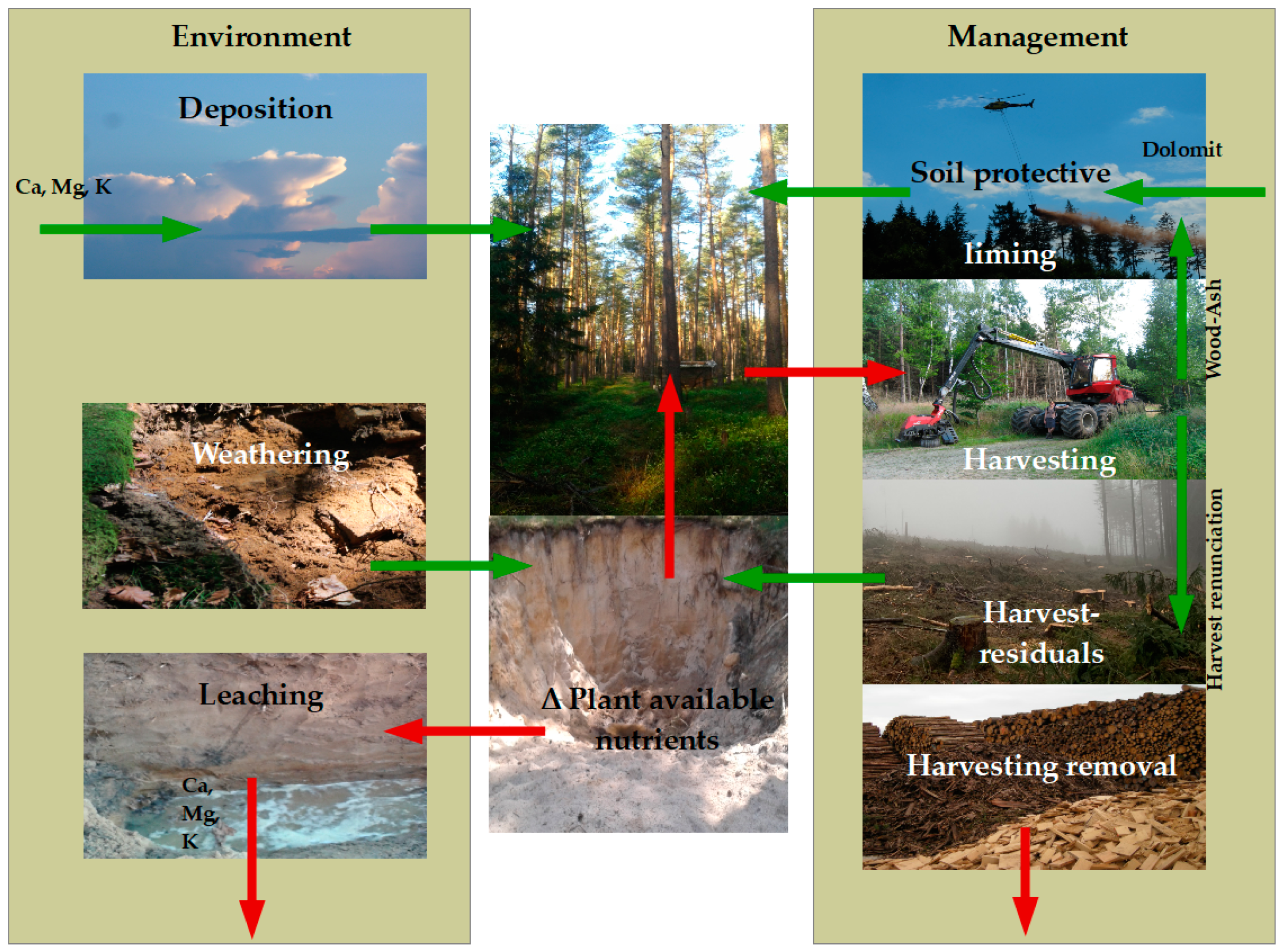
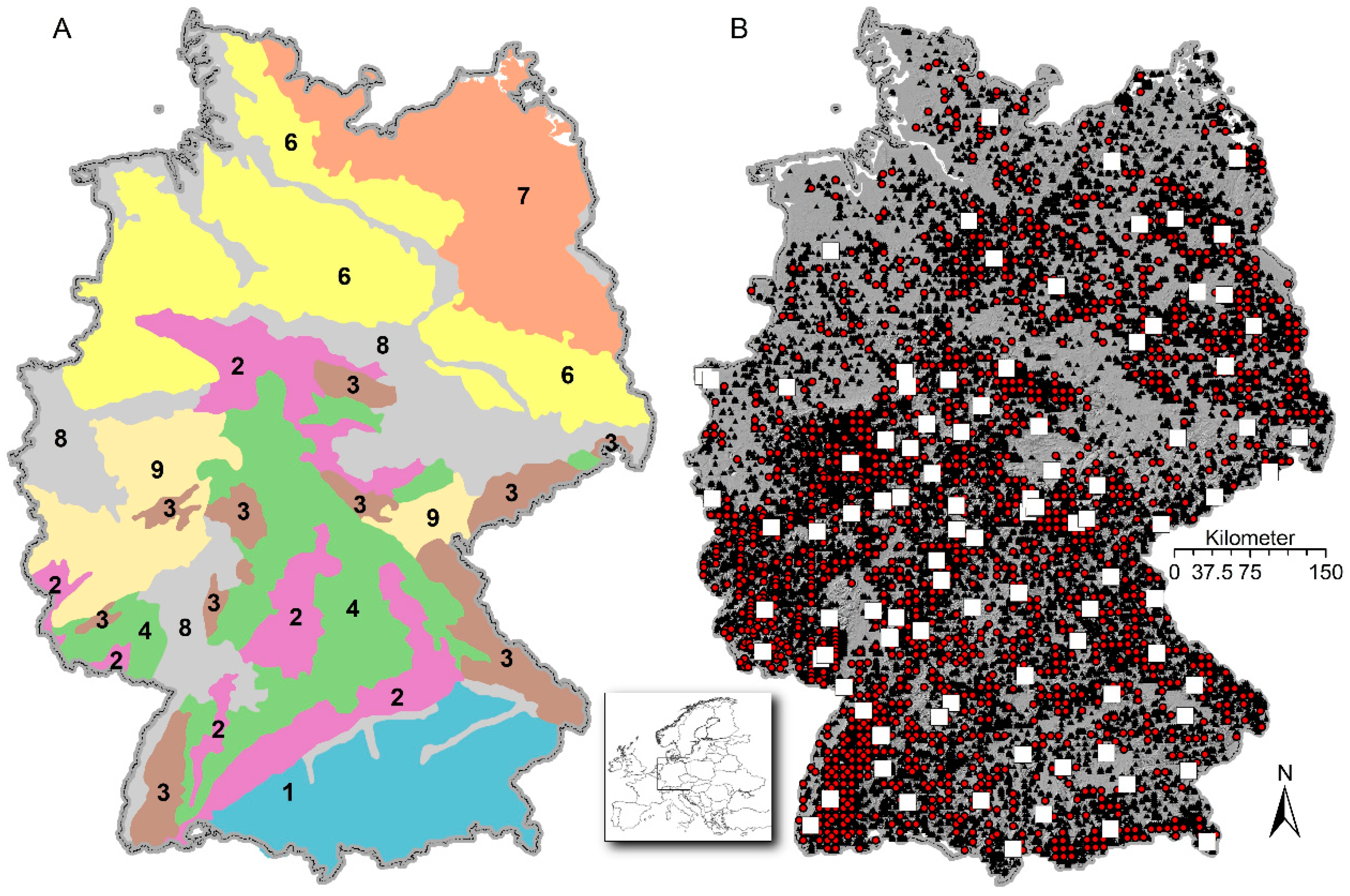
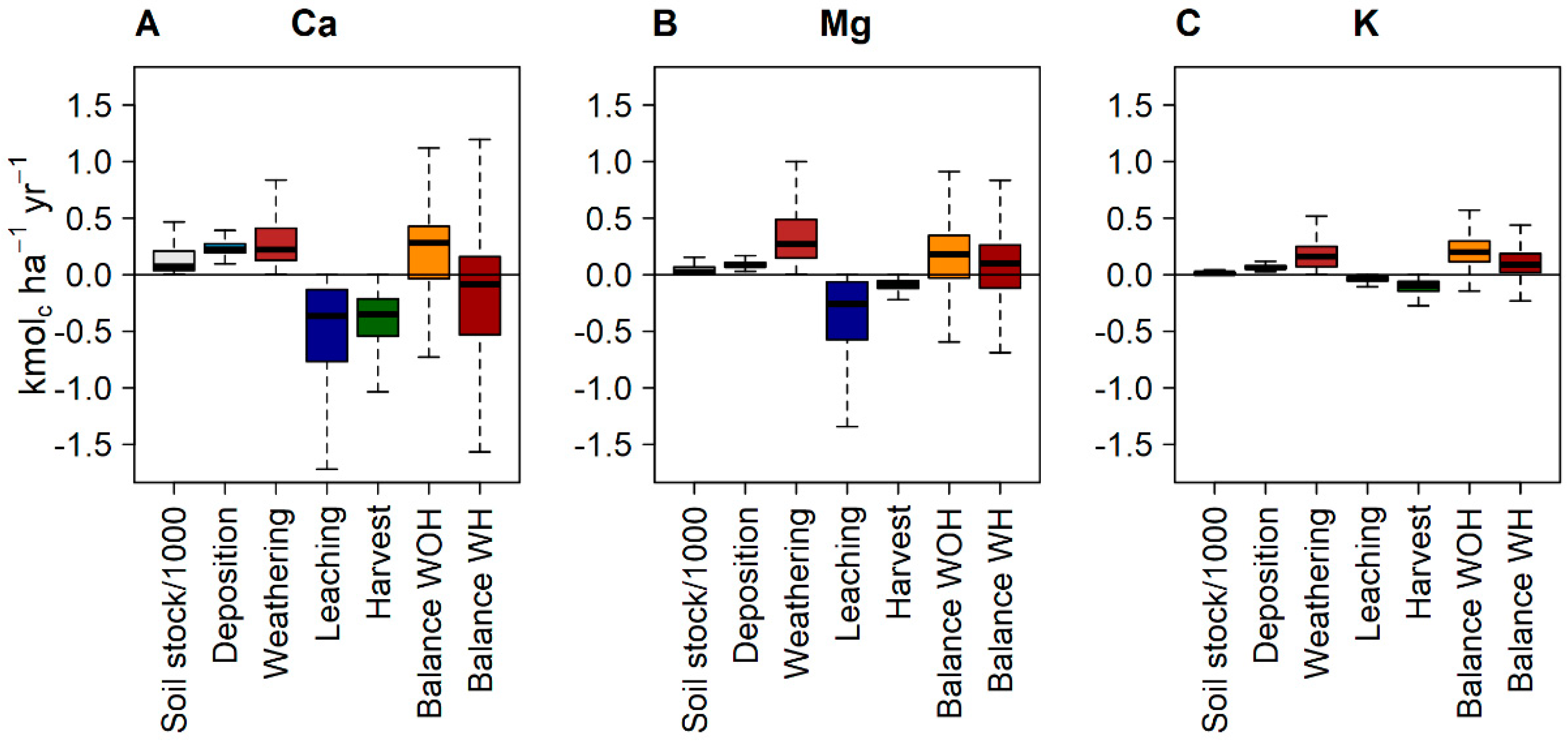
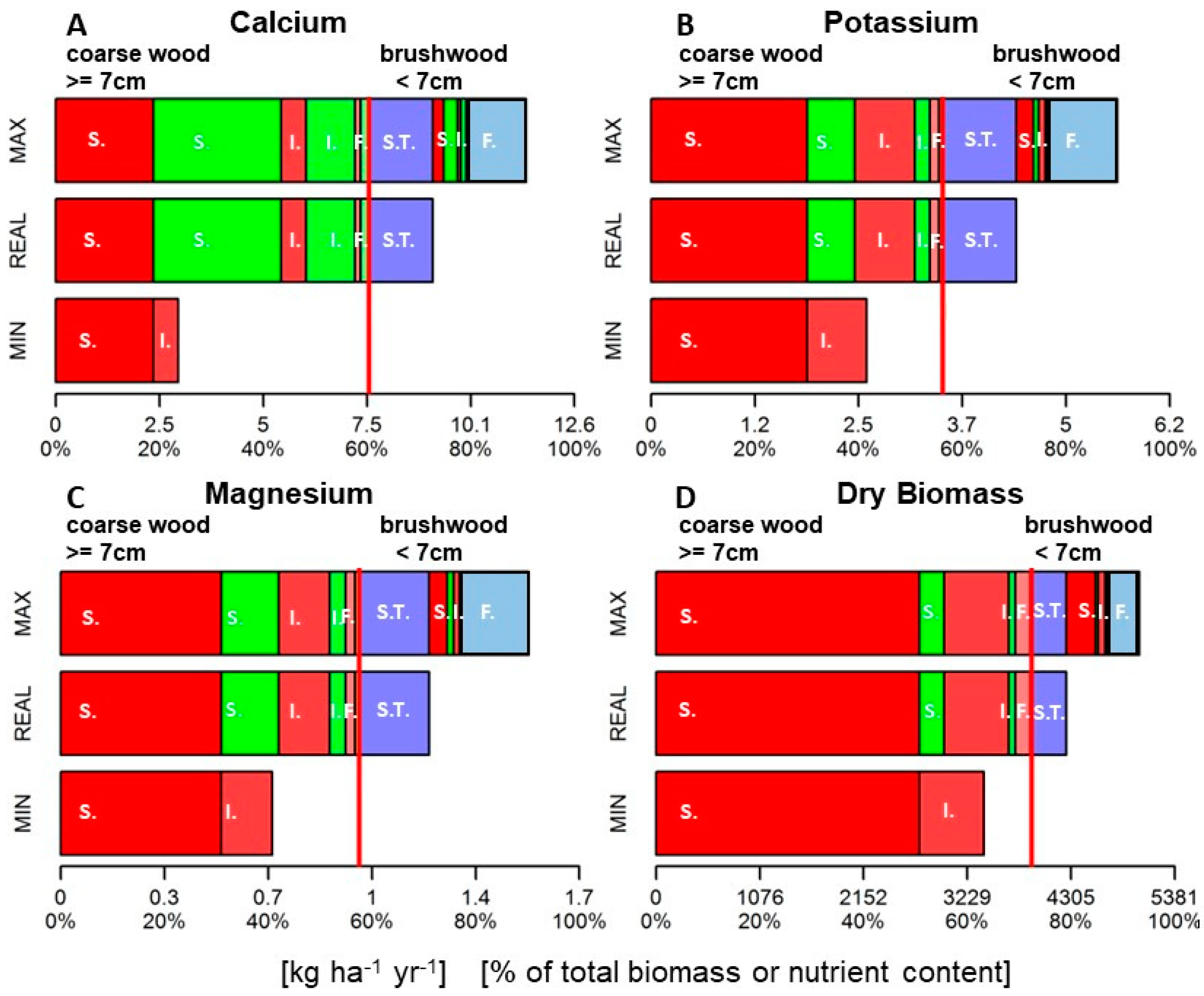
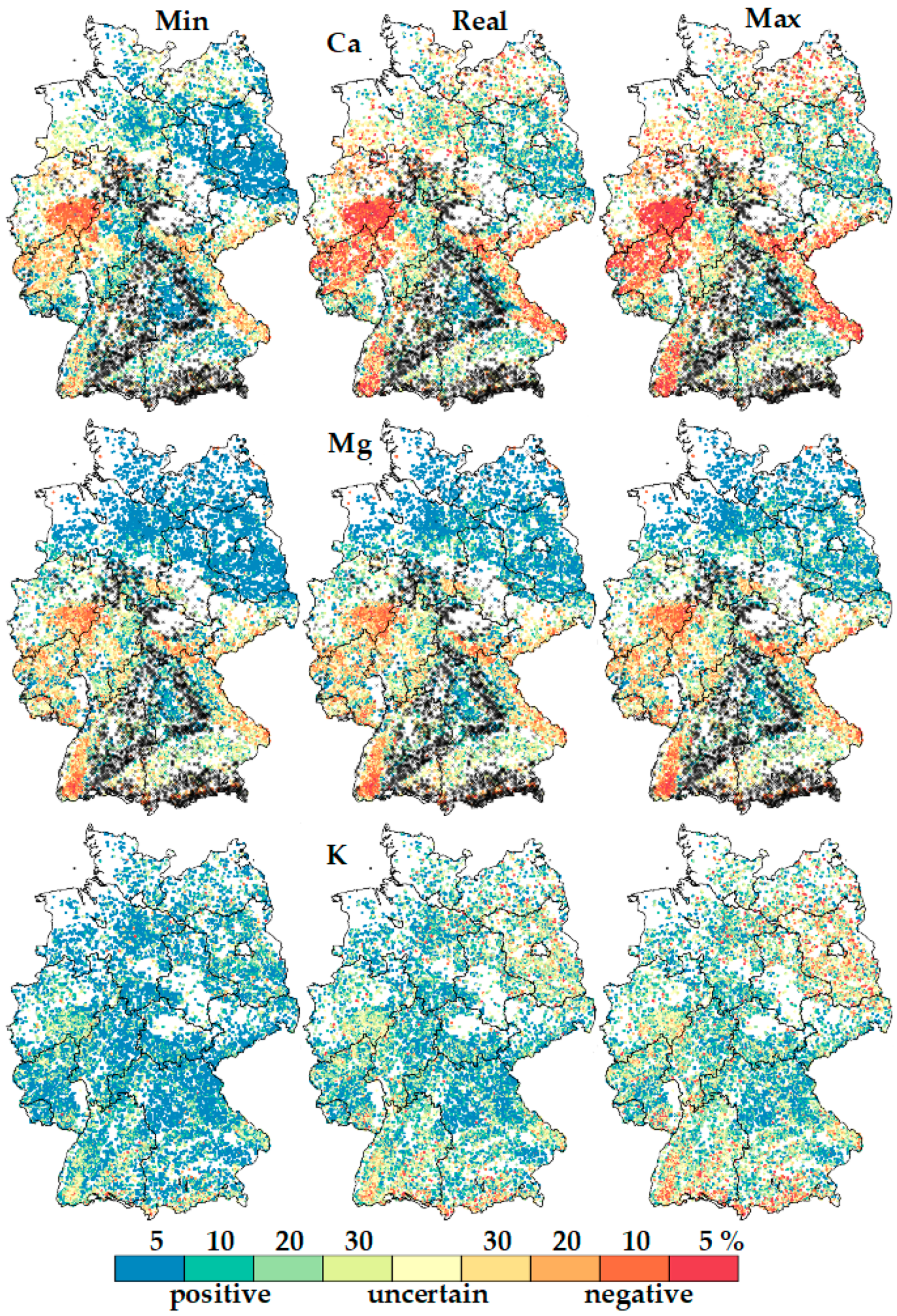
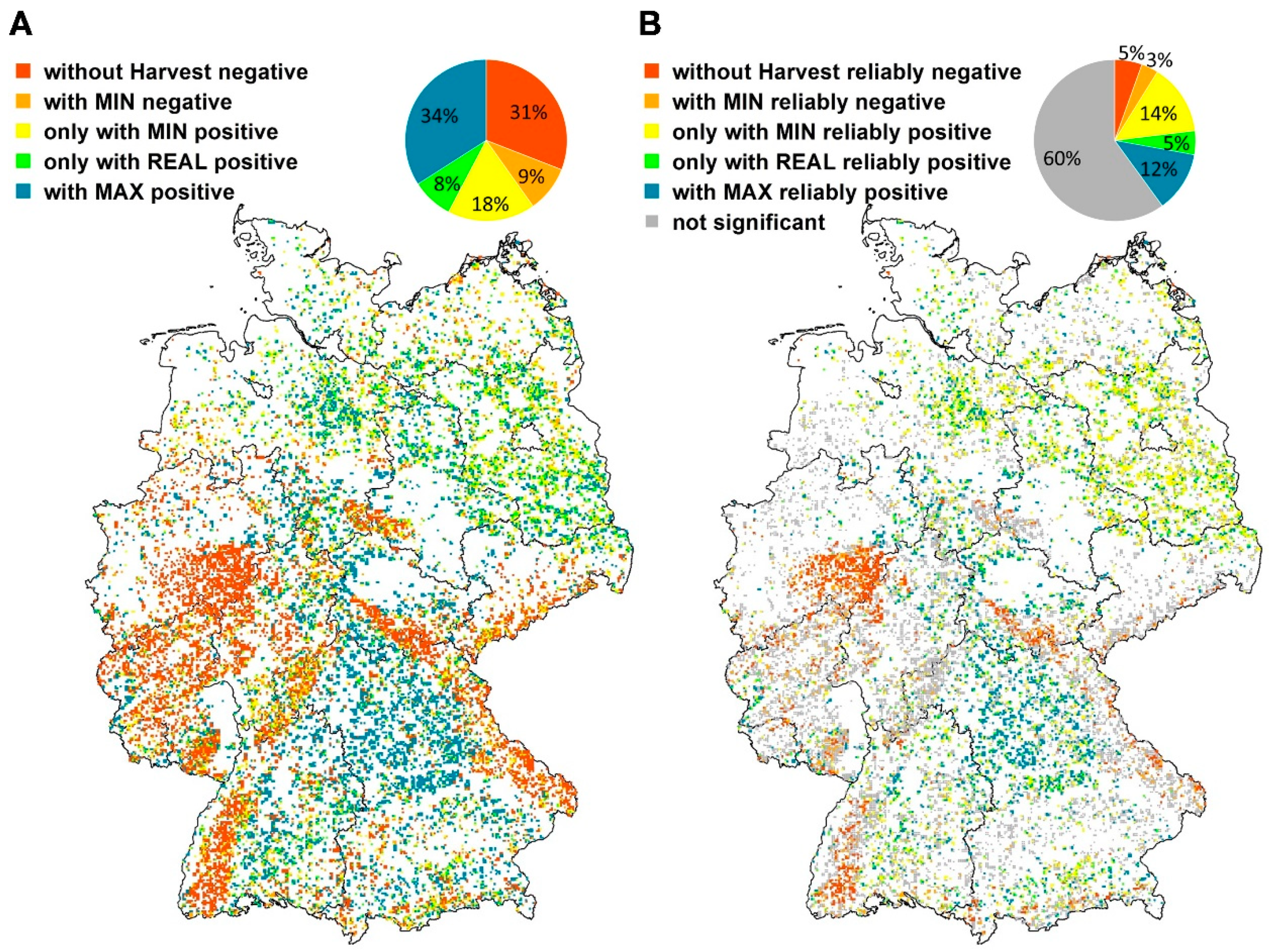
| Region | OBS | Ca Balance | Mg Balance | K Balance | ||||||
|---|---|---|---|---|---|---|---|---|---|---|
| R² | RMSE | CVRMSE | R² | RMSE | CVRMSE | R² | RMSE | CVRMSE | ||
| 1 | 63 | 0.733 | 118.580 | −8.024 | 0.640 | 35.193 | −5.940 | 0.665 | 3.990 | 0.454 |
| 2 | 44 | 0.679 | 111.700 | 2.877 | 0.015 | 38.815 | 2.870 | 0.509 | 4.726 | 0.434 |
| 3 | 79 | 0.690 | 10.000 | −2.421 | 0.527 | 6.809 | −2.625 | 0.523 | 4.125 | 0.563 |
| 4 | 126 | 0.540 | 25.631 | 4.626 | 0.226 | 8.932 | 3.369 | 0.344 | 5.213 | 0.465 |
| 6|7 | 46 | 0.650 | 7.775 | 4.527 | 0.587 | 1.992 | 0.704 | 0.800 | 1.546 | 0.305 |
| 8 | 31 | 0.584 | 36.587 | −14.405 | 0.339 | 4.168 | 1.447 | 0.382 | 4.604 | 0.611 |
| 9 | 61 | 0.623 | 12.438 | −1.553 | 0.387 | 6.041 | −1.841 | 0.475 | 3.736 | 0.485 |
| Global | 450 | 0.605 | 62.514 | −2.054 | 0.447 | 23.164 | −0.288 | 0.521 | 4.313 | 0.474 |
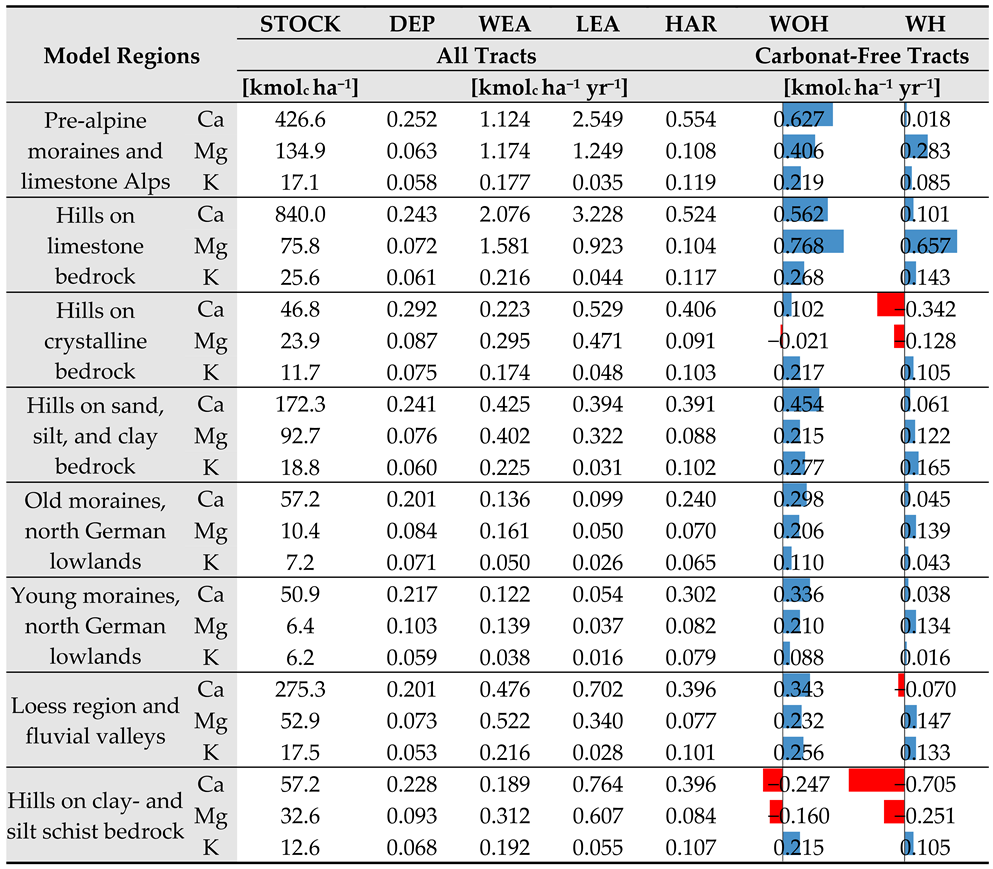 |
| Consideration Level | Unit | Nutrient Element-Combination | ||
|---|---|---|---|---|
| CaMg | CaMgK | K | ||
| Area with balance deficits | ha | 4,274,808 (39.4%) | 1,318,645 (12.2%) | 662,275 (6.1%) |
| Area with balance deficits at α < 0.1 | ha | 1,625,254 (15%) | 180,331 (1.7%) | 208,948 (1.9%) |
| Required annual treatment area | ha yr−1 | 113,740 (1.05%) | 113,539 (1.05%) | 46,346 (0.42%) |
| Required annual treatment area at α < 0.1 | ha yr−1 | 84,961 (0.78%) | 38,651 (0.36%) | 41,452 (0.38%) |
Publisher’s Note: MDPI stays neutral with regard to jurisdictional claims in published maps and institutional affiliations. |
© 2022 by the authors. Licensee MDPI, Basel, Switzerland. This article is an open access article distributed under the terms and conditions of the Creative Commons Attribution (CC BY) license (https://creativecommons.org/licenses/by/4.0/).
Share and Cite
Ahrends, B.; von Wilpert, K.; Weis, W.; Vonderach, C.; Kändler, G.; Zirlewagen, D.; Sucker, C.; Puhlmann, H. Merits and Limitations of Element Balances as a Forest Planning Tool for Harvest Intensities and Sustainable Nutrient Management—A Case Study from Germany. Soil Syst. 2022, 6, 41. https://doi.org/10.3390/soilsystems6020041
Ahrends B, von Wilpert K, Weis W, Vonderach C, Kändler G, Zirlewagen D, Sucker C, Puhlmann H. Merits and Limitations of Element Balances as a Forest Planning Tool for Harvest Intensities and Sustainable Nutrient Management—A Case Study from Germany. Soil Systems. 2022; 6(2):41. https://doi.org/10.3390/soilsystems6020041
Chicago/Turabian StyleAhrends, Bernd, Klaus von Wilpert, Wendelin Weis, Christian Vonderach, Gerald Kändler, Dietmar Zirlewagen, Carina Sucker, and Heike Puhlmann. 2022. "Merits and Limitations of Element Balances as a Forest Planning Tool for Harvest Intensities and Sustainable Nutrient Management—A Case Study from Germany" Soil Systems 6, no. 2: 41. https://doi.org/10.3390/soilsystems6020041
APA StyleAhrends, B., von Wilpert, K., Weis, W., Vonderach, C., Kändler, G., Zirlewagen, D., Sucker, C., & Puhlmann, H. (2022). Merits and Limitations of Element Balances as a Forest Planning Tool for Harvest Intensities and Sustainable Nutrient Management—A Case Study from Germany. Soil Systems, 6(2), 41. https://doi.org/10.3390/soilsystems6020041







